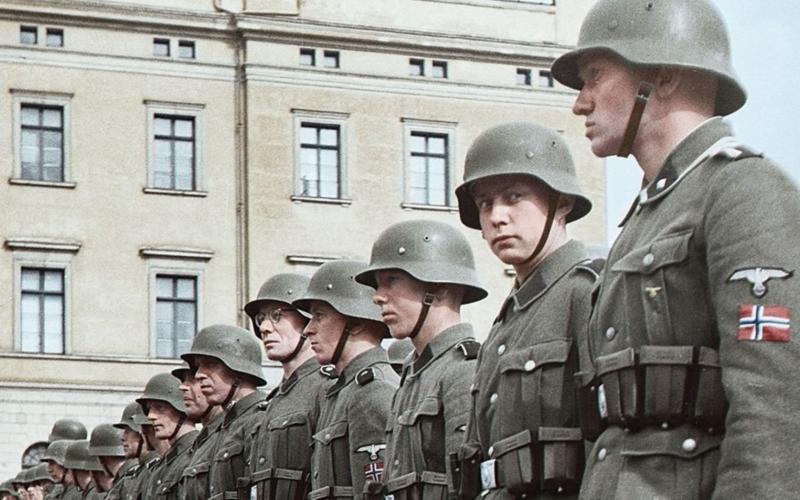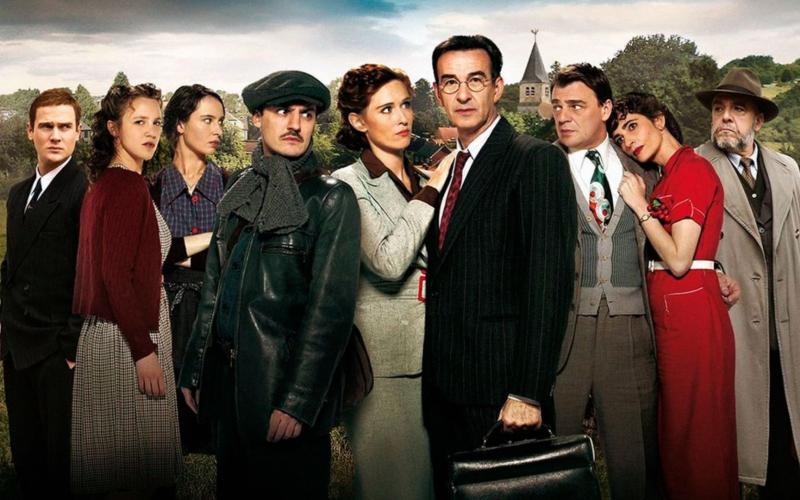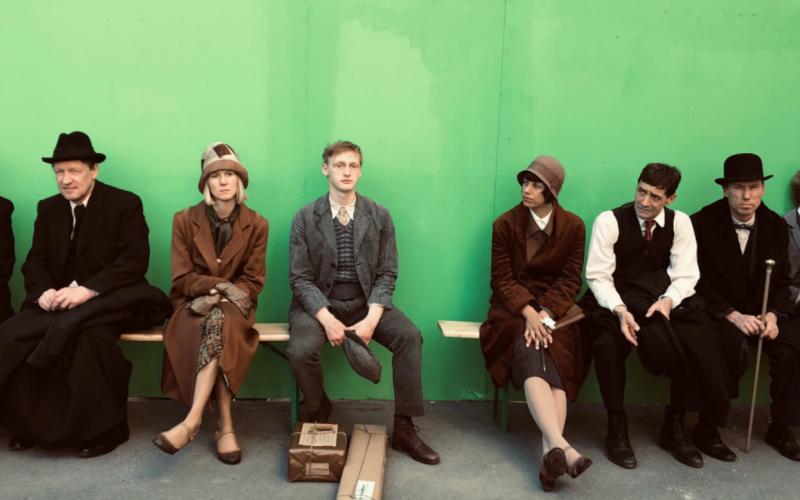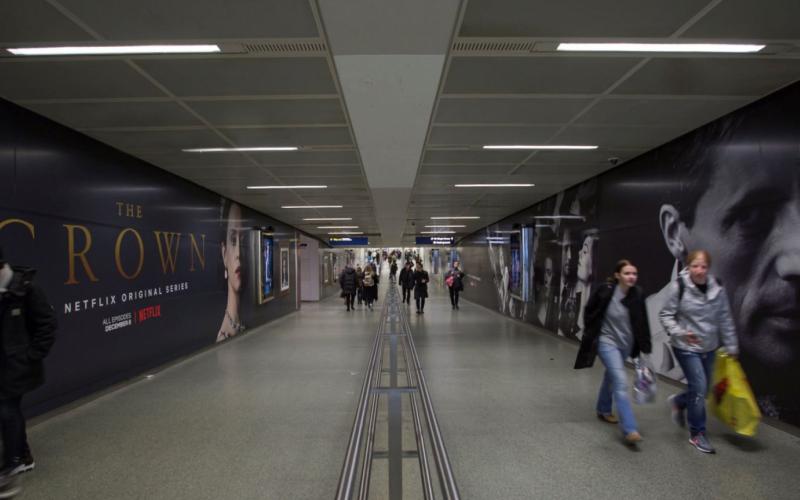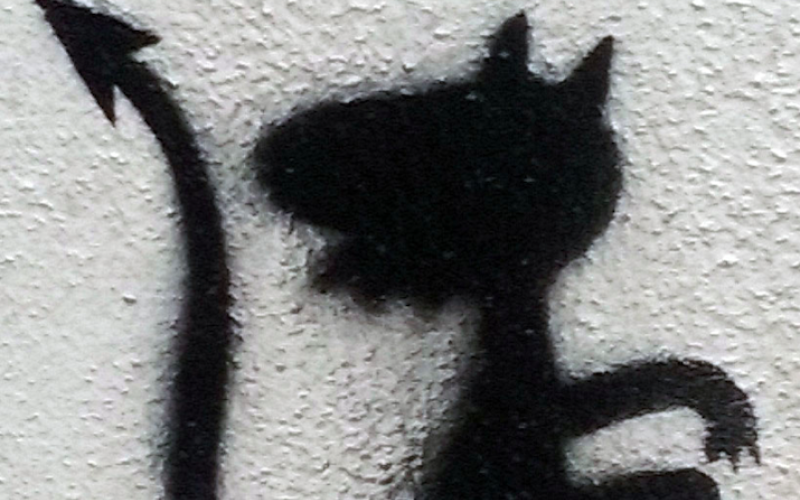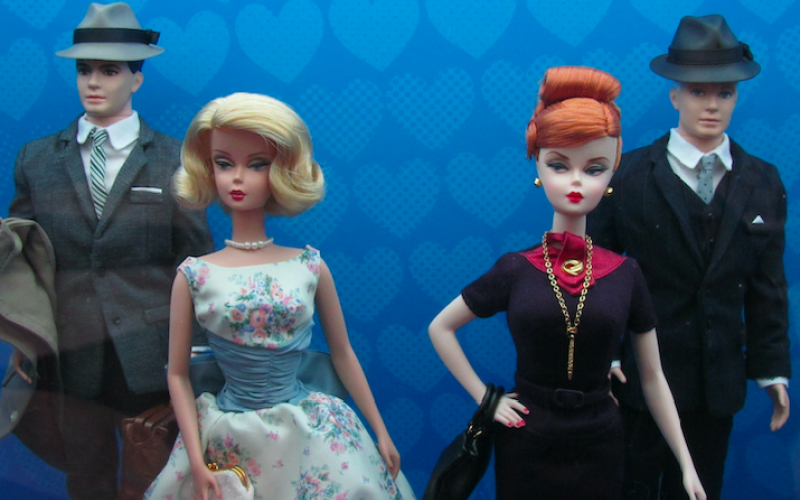In recent years, streaming services such as Netflix, Hulu and Amazon Prime offered the possibility to access internationally produced television shows and movies. One recent trend is content with a historical set or background. Although historical sets and productions have played an important role in cinematic story-telling since the early twentieth century, the immense amount of newly available digital content has a significant impact on a society's cultural memory. Cultural memory is an integral part of a society’s identity; it is often static and its ‘horizon does not change with the passage of time’.[1] It is reproduced in museums, statues, remembrance days, and texts. It is the type of memory which society can collectively call upon and recall. While cultural memory may feel vague or encased in glass cases in museums, a historical television series brings memory alive while munching on popcorn on your sofa.
Netflix, as an American based-company with numerous international subsidiaries, has begun to provide more localised television series and films calling upon cultural memory. Yet, its shows aimed primarily at its US audience often gain more international acclaim in popularity and numbers. Although recent scholarly discussion in historical accuracy and media studies provides detailed analysis of shows like Mad Men (AMC), Chernobyl (HBO), and The Crown, historians have given less attention to Netflix productions with a historical setting made primarily for a female audience. Often in these shows, more than others aimed at general audiences, fashion plays a key role in how producers construct the specific time period in which it is set. We argue that anachronic depictions of historical fashion massages current cultural memory of the past. Instead, they reproduce current gender stereotypes and signal society’s present anxieties and fears about gender identity and changing cultural norms.
To illustrate how cultural memory influences television show plots and productions, and how we, as an audience, experience cultural memory, we turn to the reproduction of gender through fashion in different television shows aired on Netflix in early 2020. The article considers television series released on Netflix for international release: Bridgerton (2020) depicting the early 19th century, followed by the Cable Girls (2015-2020) in the 1920s, and Queen’s Gambit (2020) in the 1960s. We chose these three shows due to their recent world-wide release during the pandemic, which increased the popularity of these shows, and the different historical areas in which they play. Cable Girls (1920s Spain) provides a juxtaposition to Bridgerton (early 1800s Britain) and Queen’s Gambit (1960s United States), as Cable Girls was primarily made for the Spanish market, with an English voice-over version available in other regions. All three shows have a similar premise in that they depict women who rebel or question patriarchal values and culture. We utilise Cote’s term feminist anachronistic costume drama as a means to define a historical Netflix series, which gives women more agency than was socially acceptable for the period, with a particular focus on fashion and costuming choices.[2] Our article considers the phenomena of fashion and subjectivity in historical television series to question what role it plays in each of the series and how cultural memory of the past is shaped by these types of depictions.
Postfeminism and fashion: challenging the narratives of historical dramas?
In recent years, analysis of historical television series focused on different aspects of the shows’ productions, historical accuracies of plots, and set decisions. Historians are often not consulted in set productions—much to their chagrin. Fashion in historical dramas has become a research focus especially with Mad Men, which aimed to reproduce historically accurate fashion and set pieces. Rosenheck argues that studying how in the twenty-first century fashion is presented in historical television series allows us to consider the relationship between the way the ‘embodied nature of fashion [...] highlight the status of both clothing and the series as exercises in memory’.[3] In other words, by seeing historical clothing, the viewer is challenged to remember what they wore during the same period. This creates a dialogue between the past and the present that is highly personal and relevant—creating an automatic link to the series. In addition, leaning on Charles Taylor’s argument of the archive and its repertoire, we can assert that fashion—both past and present—state something important about the past but also of the present.[4]
Feminist anachronistic costume dramas all have in common several factors: their plots revolve around women’s lives and stories, often with romantic undertones or as main plot points, and a hyper focus on fashion. Therefore, we ought to consider the way in which feminism, or rather postfeminism, is depicted and represented in television, as women’s role in society has changed overtime. Second Wave Feminism of the 1970s impacted the depiction of women in 1990s television shows, for example in Ally McBeal, L.A. Law, Sex and the City and the Alien movie series. However, in feminist media studies today the ‘latest cluster of feminisms’ (antifeminism, postfeminism, and third wave) are difficult to distinguish and, perhaps, to analyse the larger cultural ramifications how women are depicted in film.[5] Therefore, one of the larger questions we ought to ask is how should we analyse women in contemporary television shows or films. What roles are producers and writers creating for women in today’s world of multiple feminisms? Or, on the contrary, are we living in a postfeminist period? All of these questions are complex, but intricately important, as feminist anachronistic costume dramas attempt to appease multiple types of women to keep them watching and buying.
The dramas all depict at least one female character, who challenges patriarchal norms, and another character, who supports the current social situation of women. Gerhard proposes postfeminism in dramas can be seen as ‘a re-negotiation of antifeminist and feminist thought in and through popular representations of women’.[6] In other words, media depictions of women acknowledge women’s advancement in legal gains, whilst attempting to realign women with the nineteenth century concept of separate spheres. Although in the historical past, the separate spheres were a physical division of space between public spaces and private homes, today it is more tied to ideas of the ‘distinctive psychological reality of women’.[7] Women have to carve out mental spaces for themselves based on their social settings, in which they navigate social structures and hierarchies. In contemporary times of the pandemic, financial strain, anxieties, fears of terrorist attacks, and climate change, it can be felt as a relief to retract into traditional spaces and places, at least when watching TV. As Diane Negra conceptualizes it, this is a type of postfeminism that ‘offers the pleasure and comfort of (re)claiming an identity uncomplicated by gender politics, postmodernism or institution critique’.[8] These ideals, put simply, are visible in how fashion is partially utilised in historical period productions: viewers, who engage with fashion, are provided with a sense of the producers’ understandings of widespread social norms. Fashion’s role is to provide comfort in excess, lessen anxiety, and provide an accessible way to engage with history that does not overtly challenge gendered subjectivities.
Historical clothing and fashion trends
In historical television and film, clothing choices and fashion aesthetics play an important role in how audiences empathise and relate to the historical period.[9] Fashion is an important nexus as it functions as ‘archival as well as reportorial’ in film productions, as clothing can awaken memories of the historical past.[10] Fashion can trigger memories and images of our lost past or wake past memories, linking fashion directly with cultural memory.[11] We currently reside in what Fredric Jameson calls ‘postmodern culture’: capitalism has transformed culture into a ‘product of its own right. The market has become a substitute for itself and fully as much a commodity as any of the items it includes within it-self. [...] Postmodernism is the consumption of sheer commodification as a process’.[12] Following his logic, late capitalism “constructs identity through consumption and not through human relationships.” These similar ideas of postmodern culture and identity construction through purchasing fashion is a value present in the Netflix productions. The dramas show the complex, interrelated connections between historical dress, fashion, cultural memory, and postmodern culture.
One common phenomenon that brings together the dramas, especially in light of the pandemic, is the way in which Queen’s Gambit and Bridgerton utilise American cultural memory and The Cable Girls refer to the European Golden 20s. They link to a specific sense of nostalgia and performance of safety through excessive consumerism. Sturken’s argument that American cultural memory of the past is like that of a tourist—seeing the aspects that a ‘tourist’ who views the past with innocence and superficiality ‘participates uncritically in a culture in which notions of good and evil are used to define complex conflicts and tensions’.[13] Using her view of cultural memory of America, we can extend this particular point to how recent television dramas utilise the historical past and present it often rather superficially. Especially in the case of Queen’s Gambit and Bridgerton, the larger narratives show a story of uniqueness and exceptionalism of the American past. Bridgerton, although set in Georgian Britain, creates a narrative of the separate spheres of nineteenth century Europe that a modern (American) viewer could use to justify current political actions pertaining to women's legal rights. Further, the show creates a false narrative of nineteenth century fashion consumption, as women in the period did not buy new dresses for every single social event of the season, as Daphne and her mother are constantly dress shopping. This creates a comfort of consumption being show to the viewer and is often rewarded with dress purchases.
The same comfortable consumption occurs in The Cable Girls, as the main characters spend their free time buying new fashions. Although women are depicted as financially independent when working in a telephone company, the salary paid in the 1920s would not realistically have paid for this kind of lifestyle. The Queen’s Gambit, which is set in 1960s suburban America, takes a similar tourist perspective, inviting the viewer to be a spectator of the 1960s that provides a Cold War message of American capitalist triumph and individualism through excessive fashion consumption, with glimpses into its darker sides of American consumer culture of alcoholism, depression, and drug abuse.
Historical dramas or fashionable historical postfeminism?: Bridgerton, Queen’s Gambit, and Cable Girls
The success of Bridgerton during the Christmas season of 2020 illustrates that audiences enjoy (fictional) historical period dramas with which they can empathise and relate to. The plot of Bridgerton revolves around an affluent upper class British family, whose daughters and sons are looking for suitable marriage partners. The series provides commentary on gender roles, societal structures, and draws attention to the importance of racial equality in terms of casting choice. However, its use of opulent costuming choices, while following the period silhouette, do not match the fabric choices and availability of the period. Further, the characters are seen shopping for new dresses in almost every episode, suggesting that for the ultra-wealthy, buying a new custom-made dress was typical. Indeed, while the show encapsulates the term feminist anachronistic costume drama at its core, it shows how our cultural memory of the period is tied to the male gaze, comfortable consumption, husband-finding, and wish-fulfilment of idealized romance where men take the lead.
This image of consumption and consumerism more readily conveys postmodern capitalist culture, where identity is tied to what and how individuals consume. Such choices of costuming and the inspirations around it are stated by the show’s costume designer Ellen Mirojnick, who states: ‘The fashion that I’d use, we’d look at many different decades from the 20th century and actually settle upon more or less the couture of the ’50s and the early ’60s with modern elements of couture of 2018, 2019. For example, there was a way in which embellishments were used in a Chanel runway show of spring of—I think it was 2017 or 2018, I can’t remember right now—but I fell in love with those embellishments’[14]. Further, as the show’s American producer Shonda, wants her series to ‘look beautiful, luxurious, in its own way’. The importance placed upon fashion in Bridgerton provides a place of comfort in consumption, alongside creating a connection for the viewer between the importance of appearance and finding a suitable husband. Although the show attempts to integrate character archetypes of the ‘strong feminist’ and the ‘beautiful, duty-bound daughter’, other characters do not often engage in dialogue about women’s place in society. The clothing especially evokes a loud celebration of capitalist ideology. Instead, the viewer is left trapped in a postfeminist dilemma: accept the uncomplicated place of the feminine as something beautiful, idealised, and shallow in nature, or attempt to engage critically with its postfeminist performance beyond the show’s premise.
Queen’s Gambit, whilst similar to Bridgerton in its focus on fashioning identity, appears to be purposefully avoiding concessions to Second Wave Feminism and the wider societal discussions of women’s rights that were rampant in the 1960s and 1970s. The drama follows the fictional story of Beth Harmon, a child genius chess player, who becomes the world leading Chess Champion, while tackling issues of drug abuse and alcoholism. Whilst praised for the plot and its depiction of women in chess by critics, from a historical perspective the drama uses history to create or incite drama, but not actively negotiate or use it with purpose. For example, Beth is presented as more as an archetypal masculine character that is emotionless, focused, and aggressive in nature. She has only one female friend, a black girl named Jolene, whose sole purpose is to juxtapose her poorer life choices with Beth. Beth’s adoptive mother, Alma, only truly takes notice of Beth’s prodigal chess skills because it provides a promise of financial security and wealth. Alma as a character represents a stereotypical cultural memory of a sixties housewife, who is depressed and a functioning alcoholic, placing appearance as more important than intellect. As a main character, Beth does not challenge these aspects of patriarchy, but swimmingly adapts to her desires of fashion-based identity and uses shopping as a stop-gate for anxieties.
Cable Girls uses fashion as a means of creating self-identities. However, the show attempts to move beyond a postfeminist storytelling framework, by showing how the complexities of gender identity and importance of not following hierarchical patriarchal norms. Most likely due to its 1920s milieu, fashion is placed into a central role in the series, albeit without shopping scenes, unlike Bridgerton and Queen’s Gambit. In the drama, four female characters become friends as they work in a telephone company and tackle marital problems, familial duties, patriarchal society, and changing times. From the first episode of the first season onwards, the most self-confident and independent character Lidia Agiliar, is presented as a fashion advocate and punishing men for their negligent behaviour. She is dressed in expensive looking below-knee drop-waist dresses with a loose fit in different colours and high-heel shoes. In contrast, rural Marga Suárez moves to Madrid aiming to work for a telephone company. Throughout the series, the drama equates how a (female) character dresses with the character’s mental state, using outward appearance as a rather simplistic tool for self-identity. This usage of historical fashion is most visible in Sara Millán, who discovers she is transgendered, and begins a relationship with Carlota Senillosa, a feminist, independent women fighting for her right to earn her own money. In the first season of the drama, Sara questions societal norms and traditions, supported by the other cable girls, who find themselves confronted with the possibility to not only reflect on society’s gender roles, but also on their gender identity. In Season 3, Sara transitions into male, choosing the name Oscar Ruiz, and dressing in immaculate suits. In the final season, when the Franco dictatorship came to power in Spain in the mid-1930s, Oscar had to revert back to Sara again to avoid execution. By the end, all main characters get detained and imprisoned in a women’s camp. This ultimately has thrown them back to ultimate dependence on the patriarchist system, visible in the simple grey dresses they were forced to wear. Once liberated in the final episodes and fleeing from the regime, they changed back to expensive, fashionable dresses, and high heels. In the final scene of the series, the women shoot themselves to prevent to be shot by soldiers, their fashionable clothes metaphorically state their independence from Franco.
Final thoughts and conclusion
The article brings together multiple threads of contemporary postmodernist capitalistic culture in Netflix productions. As productions, they may be categorized as feminist anachronistic costume dramas, as these types of dramas do not often take time to pick costumes with care for the time period in question. In addition to period inaccuracies in fashion, the dramas focus not only on feminism, but more often, on a postfeminist cultural memory. The dramas attempt to showcase themselves as feminist and ‘woke’ in terms of the topics they attempt to discuss (women who work, abortion, drug use, alcoholism, transgender issues), but often fail at more basic feminist issues (women’s rights, social hierarchy, stereotyping, objectification of women). Turning back to the concept of the tourister, who views cultural memory and the historical past through a shallow gaze that is focused on feelings of pleasure and nostalgia, when the audience is treated in this manner, as someone who only wants to feel good about themselves and their life, there is nothing to force the viewer into a serious dialogue. In a similar vein, cultural memory is not necessarily as static in this format as in others, making it more susceptible to alterations and changes of interpretation as time passes. Netflix, as global mass media service, has a significant role to play in shaping how women come to understand the distant historical past, as well as the anxieties arising from the present. As audiences then, we need to be mindful as to what version of the past is being sold to us and how that’s influencing perceptions about women’s current place in society.
[1] Jan Assmann, “Collective Memory and Cultural Identity”, trans. John Czaplicka, New German Critique, no. 65 (April 1, 1995), 125–33.
[2][2] Rachel Vorona Cote, “Tell It Slant: The Rise of the Feminist Anachronistic Costume Drama”, Virginia Quarterly Review 97, no. 1 (2021), 146–53.
[3] Mabel Rosenheck, "Swing Skirts and Swinging Singles Mad Men, Fashion, and Cultural Memory", in Mad Men, Mad World: Sex, Politics, Style and the 1960s, ed. Lauren M. E. Goodlad, Lilya Kaganovsky, and Robert A. Rushing (Duke: Duke University Press, 2013), 162.
[4] Rosenheck, 163; Charles, Taylor, "Sources of the Self: The Making of the Modern Identity", Repr. (Cambridge: Cambridge University Press, 1998).
[5] Jane Gerhard, "Sex and the City", Feminist Media Studies 5, no. 1 (March 1, 2005), 40–41.
[6] Gerhard, 41.
[7] Gerhard, 42.
[8] Diane Negra, "What a Girl Wants?: Fantasizing the Reclamation of Self in Postfeminism", (Routledge, 2009), 2.
[9] Pieter A. Van Dijk, Liam D. G. Smith, and Betty Weiler, “To Re-Enact or Not to Re-Enact? Investigating the Impacts of First- and Third-Person Interpretation at a Heritage Tourism Site”, Visitor Studies 15, no. 1 (January 1, 2012), 48–61.
[10] Rosenheck, "Swing Skirts and Swinging Singles Mad Men, Fashion, and Cultural Memory", 163.
[11] Ksenija Bilbija, "Tortured by Fashion: Making Memory through Corporate Advertising", in Accounting for Violence: Marketing Memory in Latin America, ed. Leigh A. Payne and Ksenija Bilbija (Duke: Duke University Press, 2011), 303.
[12] Fredric Jameson, "Postmodernism, or, the Cultural Logic of Late Capitalism" (Durham, NC: Duke University Press, 1991), x.
[13] Marita Sturken, "Tourists of History" (Duke University Press, 2007), 10.
[14] Rachelle Hampton, “How Bridgerton’s Costume Designer Put Together Its Gaudiest, Tackiest Dresses (on Purpose)”, Slate Magazine, November 19, 2020.
Zitation
Janine Funke, Tiia Sahrakorpi , Remembering and selling fashion. Gender and memory in recent historical Netflix shows , in: Zeitgeschichte-online, , URL: https://zeitgeschichte-online.de/film/remembering-and-selling-fashion


